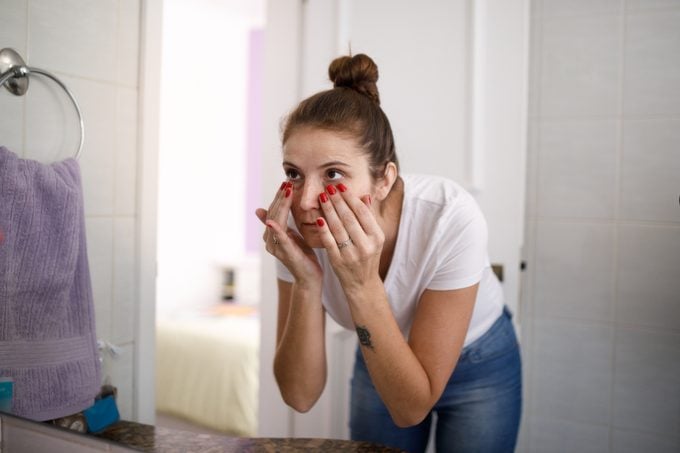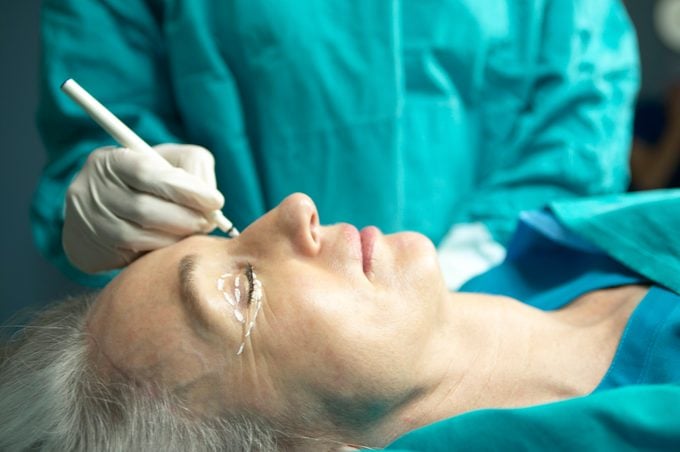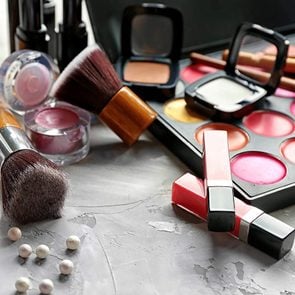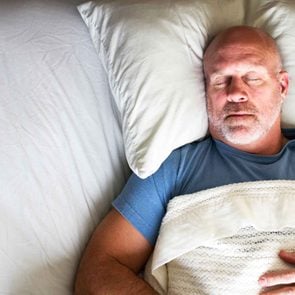What Causes Bags Under the Eyes?
Updated: Mar. 14, 2022
Are you suffering from puffy, saggy bags under your eyes? Find out what the experts say about the causes and potential treatments for under-eye bags.
Under-eye bag basics
Many of us have been there, looking in the mirror and wondering how to cover up the puffy, dark circle bags under our eyes. Sometimes these puffy bags go away a few hours after getting up or getting a solid night’s sleep. Other times, they won’t go away and only get worse over time.
According to experts like Alan Matarasso, MD, a clinical professor of surgery at Hofstra University in New York, anyone of any age can develop these pesky bags. However, they often become more pronounced with age. And once they develop, the experts say there is no true way to completely get rid of bags under the eyes except undergoing surgery.
But why do bags under the eyes develop in the first place? And what can you do about them? We got a hold of doctors who specialize in eye health and plastic surgery to get the lowdown on everything you need to know about bags under the eyes and how to get rid of them, both temporarily and for good.
What are bags under the eyes?
Several fat pads sit under and above the eye, filling the extra space between the eye and the orbit, the part of the skull that houses the eye, Dr. Matarasso explains. These pea-size fat pads cushion the eye and protect it from bouncing around when we move.
Dr. Matarasso says everyone is born with these fat pads around their eyes. “You can even look at a child 10 years and younger and see these fat pads. We all have them,” he says.
He explains that bags under the eye develop when these fat pads herniate, or bulge forward to the point they become visible under the skin. “The big question is why does this fat pad herniate, or push forward, in some people and not others,” Dr. Matarasso says.
What causes bags under eyes?
According to the experts, bags under the eye develop due to a mixture of genetics, age, and skin pigmentation. But it’s unclear what precisely causes some people to develop bags under the eyes while others do not.
Under-eye bags and aging
As we age, several things happen that can contribute to or worsen the appearance of bags under the eyes, says Bhupendra C. Patel, MD, FRCS, the chief of the Division of Facial Cosmetic & Reconstructive Surgery at the Moran Eye Center, University of Utah, in Salt Lake City.
First, he explains, we all develop some extra fat in the orbits of the eye, which shows up as “puffiness” in the upper and the lower eyelids.
With age the skin also loses some of its firmness and elasticity, causing the cheek to descend, leading to the unveiling of the lower eyelids. He says the lowering of the cheek causes a groove below the lower eyelid which tends to accentuate the puffiness of the lower eyelid.
“Furthermore, the lower eyelid structures and the tendons and muscles loosen with age, which allows the orbital fat to ride forward, making the bags look [worse] as we age,” he explains.
As you get older, the skin around your eyes also becomes thinner, and the amount of elastic and collagen fibers it contains decreases more than the surrounding skin, explains Natasha Herz, MD, a clinical spokesperson for the American Academy of Ophthalmology.
That’s why you may notice signs of aging like wrinkles around the eyes earlier than other body regions. “When things start to sag, it often happens there first,” she says. This sagging skin can also allow fat pads to bulge forward and cause bags under the eyes.
But Dr. Matarasso points out not everyone gets bags under their eyes as they age, so bags under the eyes are not an inherent part of natural aging. Why some people develop bags under the eyes and others do not is unclear.

Early-morning bags under the eyes
Experts say people may develop puffiness under the eyes that appear first thing in the morning and reduce over the day. This extra puffiness in the lower eye may also cast shadows that cause dark circles to appear under the eye.
Dr. Patel says this is because our bodies leak fluid into fat, and when we sleep, our eye movements are limited, and our eyelids do not blink, so fluid collects in the orbital fat, which can make the lower and upper eyelids look more puffy first thing in the morning. “Generally, within an hour or so, the puffiness tends to settle,” he says.
Dr. Herz says temporary puffiness or circles under the eyes do seem to be somewhat related to, or worsened by, a lack of good-quality sleep. Yet experts say the true connection between lack of sleep and bags under the eyes remains unknown.
(Here’s how else skipping sleep can make you look older.)
Genetics and bags under the eyes
Because some people develop bags under the eyes and others do not, and because they can develop at any age, experts say genetics must play some role in who gets bags under the eyes and at what point in their life. “I think a lot of it is genetic, I really do,” Dr. Herz says.
But researchers haven’t uncovered any specific genetic mutations or differences that seem to contribute to bags under the eyes. And not everyone who doesn’t get their beauty sleep develops bags under their eyes.
Experts like Dr. Herz say the structure of your eye, which is dictated by genetics, also plays a role in how noticeable bags under the eyes are and the general look of the area around your eyes. She says based on the way the orbit is formed, some people—for example, those with very deep-set eyes—may have an under-the-eye region that looks sunken, dark, or puffy.
Skin pigmentation and bags under the eyes
Dr. Herz says your level of skin pigmentation also plays a role in when signs of aging occur and how easy they are to notice. Simply put, she explains, the more pigment you have in your skin, the more elastic fibers you have as well.
And the more elastic fibers you have in your skin, the longer it may take for you to develop sagging, which contributes to under-the-eye bags and signs of aging like wrinkles around the eye.
“The darker your skin is the more elastic you have in your skin, which means if you have darker skin, you’re more likely to keep looking young for longer,” she says.
Lifestyle factors and bags under the eyes
The experts say lifestyle factors do not seem to cause bags under the eyes directly, though they may worsen them. Aside from not getting enough sleep, Dr. Matarasso says anything that causes you to retain fluid, like eating too much salt or alcohol, can cause under-the-eye bags to get puffier and look worse, but only in people prone to them.
Dr. Patel says the following factors may also worsen the appearance of bags under the eyes:
- smoking
- excessive exposure to sun
- underlying disease such as thyroid disease, renal disease, etc.
- trauma (injury)
- allergies
- sinus disease
Eye bag treatment
Experts say there is no way to remove under-the-eye bags without undergoing surgery to remove part of these fat pads and eyelid skin.
But for very small, minor bags under the eyes, there are a few procedures that may reduce the appearance of under-eye bags.
“Fillers are a nonsurgical option that fill in the depressions below the fat pad, but this is generally not as effective when fat pads are large,” says Brett Kotlus, MD, FACS, a cosmetic oculoplastic surgeon in New York who specializes in both nonsurgical and surgical cosmetic and reconstructive procedures of the eyes and face.
The American Academy of Ophthalmology (AAO) also notes laser resurfacing may help smooth the skin and reduce the appearance of bags under the eyes.
“If there is only a small amount of bags you may be able to help reduce [bags under the eyes] with a chemical peel, which helps tighten, by essentially scarring, the skin,” Dr. Herz says.
But she adds that sometimes these minor procedures aren’t enough to create the kind of change people are looking for.
She says she always recommends going to a doctor or surgeon who can perform minor procedures and true corrective surgery to ensure you have someone who knows what treatments will actually work. That can save you the hassle, and potential health risks, of undergoing pointless procedures.
Eye bag surgery
Again, experts say going under the knife is the only effective way to permanently remove or reduce bags under the eyes.
“Blepharoplasty is a surgical procedure that removes or repositions the fat, so the bulge is not seen,” Dr. Kotlus says.
During a blepharoplasty surgery, excess eyelid skin may also be removed to tighten the area and reduce the appearance of bulging or sagging, experts say.
Undergoing surgery involving the eye is a scary thought for many people, but blepharoplasty is a common and relatively quick surgery, Dr. Matarasso says, often only taking about 30 minutes.

When to talk to a doctor about under-eye bag surgery
If bags under your eyes bother you, there’s no point in waiting until you get older to have a blepharoplasty surgery, experts say.
Unlike many cosmetic procedures, once the fat pads and eyelid skin are removed, the effect is permanent. In other words, bags under the eyes will not regrow or require additional surgeries later in life.
“Many people make the big mistake of saying they’re only 30 or 40 so should wait to have surgery done, but there’s no point in spending all those years walking around with something you’re unhappy with or people saying you constantly look tired, which is many people’s largest complaint with under-the-eye bags,” Dr. Matarasso says.
“If a qualified, experienced surgeon says the procedure is likely to work, you might as well do it as soon as possible,” he says.
He adds that he has done plenty of blepharoplasties on people in their 20s and they are thrilled with the results. And unlike a lot of other cosmetic surgeries, you won’t be knocked out by a blepharoplasty.
“You can literally go home the day after surgery, put on some concealer and attend a Zoom call with confidence,” Dr. Matarasso says. “And it’s actually better, if you can, to have procedures like this done when you are younger, healthier, and more likely to recover well.”
“If you’re going to have cosmetic work done, and I’m not just saying this because I do this work, I personally feel [blepharoplasty] is one of the first things you can do to help prevent the look of aging because an eyelid lift really does help you look younger and keeps you looking younger for longer,” Dr. Herz says.
Eye-bag removal surgery considerations
Experts say one of the most important considerations before undergoing surgery to remove bags under the eyes is the experience and skill of the surgeon performing the procedure.
Dr. Herz says for lower-lid surgeries, she always recommends going to someone who specializes in this procedure and has undergone years of additional training and fellowships.
“It is very important to pick a surgeon who is not only board-certified but also a member of a well-known, large professional organization and with a special focus or interest in cosmetic surgery, meaning they do mostly these kinds of procedures day in day out, versus surgeons who specialize in fields like reconstructive surgery for someone with say breast cancer,” Dr. Matarasso says.
Dr. Herz echoes the need to pick a highly trained surgeon for lower-lid surgeries, citing the nerves and blood vessels that go through the fat pads around the eye.
“You don’t want to take a risk that you will have nerve damage and facial numbness, or if they take out too much fat and then the eye looks sunken and even worse.”
The cost of a blepharoplasty varies depending on a few factors, experts say. But Dr. Matarasso says most blepharoplasties cost around $3,000 to $6,000, depending on the skill and experience of the surgeon as well as how long the surgery takes.
How to get rid of bags under eyes with at-home remedies and treatments
No lotions, potions, creams, serums, gels, or devices can permanently reduce the appearance of or remove bags under the eyes.
That said, Dr. Matarasso and others say some ingredients in products can temporarily improve the look of under-eye bags.
“Ingredients that cause skin cells to shrink, like caffeine, can temporarily improve the look of bags under the eyes,” Dr. Matarasso says. He adds that some fashion models in the 1990s used over-the-counter products that cause the skin to constrict, like Preparation H, to temporarily reduce under-eye bags.
Dr. Patel says that although some home remedies for bags under the eyes are “old wives’ tales,” others really do work, if only for a while.
He says cucumber slices on bags under the eyes are popular because cucumber contains ascorbic acid and other acids, which can make the skin tighter and reduce skin inflammation. “Apply sliced, cool cucumber on your eyelids for 20 minutes and voila!”
He says bags of tea and other herbal infusions, in particular chamomile bags, also act naturally as an anti-inflammatory to reduce puffiness. For the best effects, he adds, first heat the tea bags in hot water, then cool and use them for 30 minutes.
According to the AAO, a few other at-home tricks may help reduce the appearance of bags under the eyes, including:
- applying a cool or cold compress, like a wet facecloth, to the areas while sitting upright
- sleeping with the head slightly up
- limiting salt intake
- trying not to drink too many fluids before bed
- getting enough sleep
- taking appropriate allergy medications
- avoiding excess rubbing of the eye
- quitting smoking
- using cosmetics like concealer to cover bags
Topical products for under-eye bags
“In general, topical creams don’t help with bags long-term,” Dr. Kotlus says.
“Current topical products don’t modify the fat pads. This is why so many patients come to me after spending exorbitant amounts of money on creams with no resolution until they do surgery.”
Dr. Kotlus says temporary improvement can occur for a period of hours with tightening creams, such as products that use silicates to tighten the skin over the bag.
Dr. Herz adds that some products contain witch hazel, which may help draw puffiness and excess fluids out of the bags under your eyes.
Dr. Patel says he recommends good hydration, proper use of sunscreen, moisturizing, and applying vitamin C serum to lower eyelids to improve the look of under-eye bags. “Vitamin C is an antioxidant, which protects the skin from free radicals,” he says.
Bags under eyes in men vs. women
Experts say there’s no real difference in how commonly, or how severely, under-eye bags affect men compared with women. They do note, however, that women often tend to hate the look of, or be more aware of, cosmetic changes like bags under the eyes.
Botox for under-eye bags
Experts agree: Botox absolutely does not help treat bags under the eyes. Botox relaxes facial muscles, and that is a factor in why the eyes’ fat pads bulge and create bags to begin with.
“Botox is only for expression wrinkles. It doesn’t aid in eye bags,” Dr. Kotlus says.
When to worry about bags under the eyes
The AAO says bags under the eyes are almost always harmless and simply a cosmetic nuisance. But if bags under the eyes are itchy, red, swollen, or painful, talk to a doctor as soon as possible.
Now that you know what causes bags under eyes, learn about the best eye creams for dark circles.




















